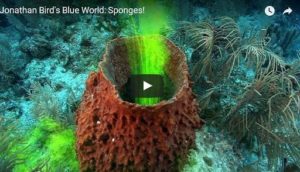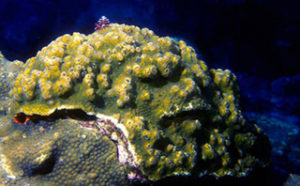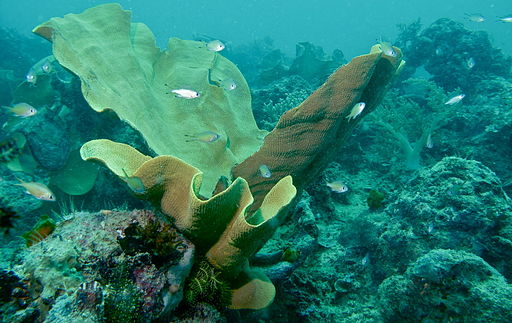VIDEO 9:44
Jonathan Bird demonstrates the power behind the “sponge loop.”

The video below, “Jonathan Bird’s Blue World,” after showing some of the history of sponge harvesting, demonstrates by applying green dye to the base of numerous sponges how effective the sponge is in filtering out food from ocean water and thereby harvesting the sugar waste excreted by coral in a reef environment.
In turn, the sponge excrement is deposited in a form that allows it to be ingested by sea creatures who inhabit the reef, which creatures subsequently are eaten by larger predators, so that the food chain is sustained.
A very clear illustration of the structure of the sponge occurs in the middle of this video which is well worth a review.
To see the coral reef’s part in originating the stringy detritus that is ingested by the sponge population, visit the next page.
!–nextpage–>

Image of Montastraea franksii, a species of coral, by NOAA – Joyce and Frank Burek [Public domain], via Wikimedia Commons.
Mucous excretion by coral fuels the sponge loop.
VIDEO 46 seconds
In studying the benefit of sponges to the coral reef environment, the contribution of coral to the reef is another part of the food cycle.
The video below is unique in showing mucous exuded by coral, in a cleansing process that provides sugars from carbon to the water of the reef, making those sugars available to sponges.
The University of Amsterdam followed their 2013 research in a 2015 study of whether sponges continued to benefit the reef at greater depths.
The researchers found that coral mucus, which is continuously released by corals in large quantities, is rapidly taken up by neighbouring sponges.
This is remarkable because the majority of this coral mucus immediately dissolves in the water (in the form of sugars for example) and cannot be taken up by most reef inhabitants. Sponges, however, exhibit the unique ability to transform the energy and nutrients stored in dissolved coral mucus to other reef organisms, by transforming it to particulate pellets.
. . . . Coral mucus may be a major Dissolved Organic Matter source for the sponge loop, but mucus uptake by sponges has not been demonstrated. Here we used laboratory stable isotope tracer experiments to show the transfer of coral mucus into the bulk tissue and phospholipid fatty acids of the warm-water sponge Mycale fistulifera and cold-water sponge Hymedesmia coriacea, demonstrating a direct trophic link between corals and reef sponges.
Furthermore, 21–40% of the mucus carbon and 32–39% of the nitrogen assimilated by the sponges was subsequently released as detritus, confirming a sponge loop on Red Sea warm-water and north Atlantic cold-water coral reefs. The presence of a sponge loop in two vastly different reef environments suggests it is a ubiquitous feature of reef ecosystems contributing to the high biogeochemical cycling that may enable coral reefs to thrive in nutrient-limited (warm-water) and energy-limited (cold-water) environments.
To read the entire detailed research article visit www.uva.nl

